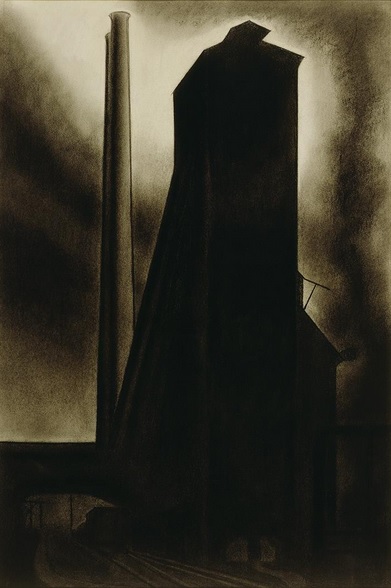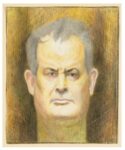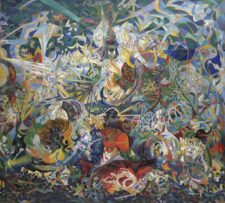See also Stella, Joseph – The By-Product Storage Tanks

Joseph Stella
Italian, 1877-1946 (active USA)
The Crusher and Mixer Building, 1918-1920 ca.
charcoal on paper
34 1/2 × 22 7/8 in.
SBMA, Gift of Wright S. Ludington
1944.2.9

Self Portrait, ca. 1945, © Whitney Museum of American Art
"I was thrilled to find America so rich with so many new motives to be translated into a new art. Steel and electricity had created a new world. A new drama had surged from the unmerciful violation of darkness at night." - Joseph Stella

Stella, Joseph - Battle of Lights, Coney Island, Mardi Gras, 1913-1914
COMMENTS
"Joseph Stella was born on June 13, 1877 in Muro Lucano, Italy. He is most famously regarded as a prominent Italian-born American Futurist painter. However, he is also noted for his exploration of a myriad of styles and subjects. His most famous works concentrate on depictions of America’s industrialist era.
Originally, Stella’s work resembled characteristics of an academic realist. He placed great emphasis on the standards developed during the Neoclassicism and Romanticism movements. However, his latter pieces began to resemble a more modernist style. His more mature pieces are noted for their exaggerated and dynamic linear structures." (Pompos)
"Stella's Futurist period began around 1913 after four years in Europe where he met leading Parisian artists [Cézanne, Matisse and the Cubists] and the Italian Futurists Boccioni, Carrà and Severini. On his return to America he exhibited in the Armory Show and was associated with the New York Dada group. " (MoMA)
"Encouraged by the response of a few New York galleries and patrons, who, as a consequence of the show, began to exhibit and buy the most advanced art, Stella committed himself wholly to Modernism. At the Armory Show he exhibited 'Battle of Lights, Coney Island, Mardi Gras' (1913; New Haven, CT, Yale U. A.G.), a synthesis of Futurist and Orphist aesthetics and methods that transforms the swirling crowds of the amusement park into confetti-like bits of bright color." (Jaffe)
"Between 1908 and 1924, Stella completed several commissions for the magazine "The Survey", including a pictorial essay of six illustrations for an issue titled "Giant Power" (March 1, 1924). For this project, Stella visited a coal processing plant in Bethlehem, Pennsylvania, and portrayed the successive stages in the creation of coal byproducts." (Met)
The Legacy of Joseph Stella
[Later in his career] "Stella's depictions of New York's cityscapes and industrial architecture led him to become a major figure in the Precisionist movement… which celebrated the industrial, modern landscape of the United States through geometric, Cubist-inspired depictions of factories, bridges, and skyscrapers. Before the early-20th century such industrial and utilitarian structures were not typical subjects for artists, but, with the help of artists like Stella, industrial architecture became a powerful symbol of the distinct textures of American life for many artists. This was the first indigenous modern art movement in America, and included artists such as Charles Demuth, Charles Sheeler, Gerald Murphy, Elsie Driggs, and Niles Spencer. Like Stella, these artists chose subjects that were unique to 20th-century life, including skyscrapers, suspension bridges, and factory complexes.
His earlier, more abstract pieces such as Battle of Lights, Coney Island, Mardi Gras (1913-14) can be said to have anticipated Abstract Expressionism and the Action Paintings of Jackson Pollock. Stella's dynamic, ever-changing style also had a tremendous impact on later artists, including the Color Field paintings of Helen Frankenthaler, the post-Cubist works of Edgar Ewing, and the Abstract Realist urban scenes of De Hirsh Margules, to name just a few." (Art Story)
References
Natalie Pompos, “Joseph Stella”, Art History at PEA
https://arthistoryatpea.wordpress.com/cubism-futurism-neo-plasticism/futurism/joseph-stella/
MoMA Press Release, 10/26/1960
https://assets.moma.org/documents/moma_press-release_326209.pdf
Irma B. Jaffe, "Joseph Stella", Grove Art Online, 2003
https://doi.org/10.1093/gao/9781884446054.article.T081269 (subscription required)
The Met Collection
https://www.metmuseum.org/art/collection/search/488616?searchField=All&sortBy=Relevance&ft=joseph+stella&offset=0&rpp=20&pos=9
The Art Story
https://www.theartstory.org/artist/stella-joseph/life-and-legacy/#nav
BIBLIOGRAPHY courtesy Allyson Healy, SBMA Curatorial Department
Baur, John I. H and Whitney Museum of American Art. Joseph Stella: An Exhibition At the Whitney Museum of American Art. New York: New York, 1963, 1963.
Brown, Milton. American Painting from the Armory Show to the Depression. Princeton: Princeton University Press, 1955.
Carnegie Institute. Forerunners of American Abstraction Painters: Charles Demuth, Arthur G. Dove, John Marin, Georgia O'Keeffe, Charles Sheeler, Joseph Stella; Sculptors: John B. Flannagan, John Storrs. 1971.
Corn, Wanda. "An Italian in New York" (pp. 135–190) in Corn, The Great American Thing: Modern Art and National Identity, 1915–1935. Berkeley: University of California Press, 1999.
Davidson, Abraham A. Early American Modernist Painting, 1910–1935. New York: DaCapo, 1994 edition.
Haskell, Barbara. Joseph Stella. New York: Whitney Museum of American Art (exhibition catalogue), 1994.
Hughes, Robert. American Visions: The Epic History of Art in America. New York: Knopf, 1997.
Hunter, Sam. Modern American Painting and Sculpture. New York: Dell, 1959.
Jaffe, Irma. Joseph Stella. New York: Fordham University Press, 1988 edition.
Jaffe, Irma B. "Joseph Stella and Hart Crane: The Brooklyn Bridge." American Art Journal (1969): 98-107.
Moser, Joann. "The Collages of Joseph Stella:" Macchie/Macchine Naturali"." American Art 6, no. 3 (1992): 59-77.
Stella, Joseph, and Joann Moser. Visual Poetry: The Drawings of Joseph Stella. Washington: Published for the National Museum of American Art by the Smithsonian Institution Press, 1990.
Zilczer, Judith. Joseph Stella, the Hirshhorn Museum and Sculpture Garden Collection. Washington, D.C.: Published for the Hirshhorn Museum and Sculpture Garden by the Smithsonian Institution Press, 1983.
SBMA CURATORIAL LABELS
Though academically trained, Stella decided to fully commit to modernism after realizing its impact through the 1913 Armory exhibition in New York. An artist of outsized personality, he was a participant in Gertrude Stein’s social scene, and was a cohort of Marcel Duchamp’s. A restless artist, Stella absorbed many different trends at the turn of the last century, including Cubo Futurism, Surrealism, and as this drawing attests, American Precisionism. Stella was fully conscious of the infernal conditions of these industrial mills and described them as “a new divinity, more monstrous and cruel than the old one.” In this drawing, he expertly manipulated the charcoal medium to capture a hard-edged, looming silhouette of the building, backlit and surrounded by sooty plumes of smoke, creating a menacing air.
- Important Works on Paper, October, 2020
